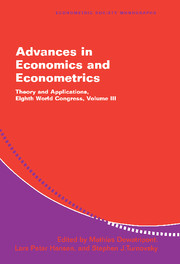Book contents
- Frontmatter
- Contents
- List of Contributors
- Preface
- 1 Contracting Constraints, Credit Markets, and Economic Development
- 2 Factor Models in Large Cross Sections of Time Series
- 3 Macroeconomic Forecasting Using Many Predictors
- “Big Data” Dynamic Factor Models for Macroeconomic Measurement and Forecasting: A Discussion of the Papers by Lucrezia Reichlin and by Mark W. Watson
- 4 How Severe Is the Time-Inconsistency Problem in Monetary Policy?
- 5 New Perspectives on Monetary Policy, Inflation, and the Business Cycle
- Comments on Papers by Stefania Albanesi, V. V. Chari, and Lawrence J. Christiano and by Jordi Galí
- 6 Consumption Smoothing and Extended Families
- 7 Computational Methods for Dynamic Equilibria with Heterogeneous Agents
- Index
“Big Data” Dynamic Factor Models for Macroeconomic Measurement and Forecasting: A Discussion of the Papers by Lucrezia Reichlin and by Mark W. Watson
Published online by Cambridge University Press: 06 January 2010
- Frontmatter
- Contents
- List of Contributors
- Preface
- 1 Contracting Constraints, Credit Markets, and Economic Development
- 2 Factor Models in Large Cross Sections of Time Series
- 3 Macroeconomic Forecasting Using Many Predictors
- “Big Data” Dynamic Factor Models for Macroeconomic Measurement and Forecasting: A Discussion of the Papers by Lucrezia Reichlin and by Mark W. Watson
- 4 How Severe Is the Time-Inconsistency Problem in Monetary Policy?
- 5 New Perspectives on Monetary Policy, Inflation, and the Business Cycle
- Comments on Papers by Stefania Albanesi, V. V. Chari, and Lawrence J. Christiano and by Jordi Galí
- 6 Consumption Smoothing and Extended Families
- 7 Computational Methods for Dynamic Equilibria with Heterogeneous Agents
- Index
Summary
BIG DATA
The Reichlin and Watson papers are just what we have come to expect from their authors: practical and pragmatic, yet grounded in rigorous theory. In short, good science.
Recently, much good science, whether physical, biological, or social, has been forced to confront – and has often benefited from – the “Big Data” phenomenon. Big Data refers to the explosion in the quantity (and sometimes, quality) of available and potentially relevant data, largely the result of recent and unprecedented advancements in data recording and storage technology. In this new and exciting world, sample sizes are no longer fruitfully measured in “number of observations,” but rather in, say, megabytes. Even data accruing at the rate of several gigabytes per day are not uncommon. Economics examples include microeconometric analyses of consumer choice, which have been transformed by the availability of huge and detailed data sets collected by checkout scanners, and financial econometric analyses of asset return dynamics, which have been similarly transformed by the availability of tick-by-tick data for thousands of assets.
From the vantage point of the examples just sketched, the Reichlin and Watson papers do not analyze really Big Data, but they certainly represent a movement of macroeconometrics in that direction.
Information
- Type
- Chapter
- Information
- Advances in Economics and EconometricsTheory and Applications, Eighth World Congress, pp. 115 - 122Publisher: Cambridge University PressPrint publication year: 2003
Accessibility standard: Unknown
- 31
- Cited by
